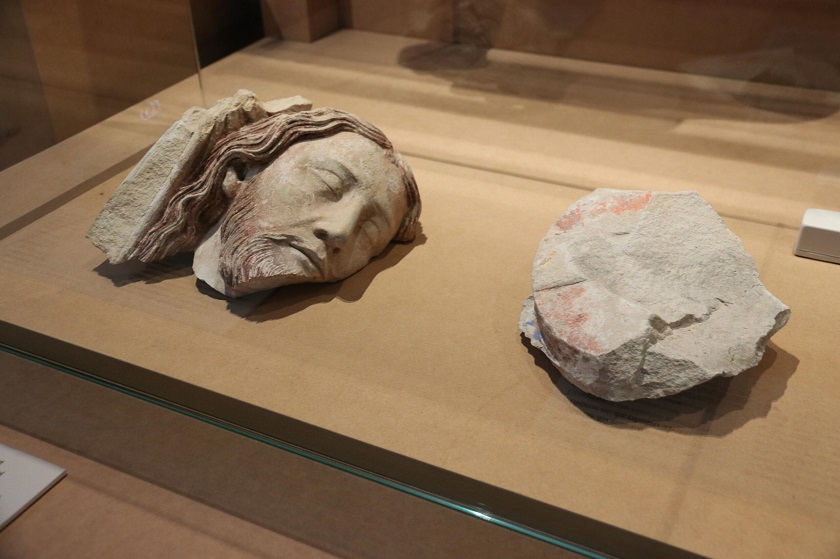-
17:20
-
17:00
-
16:50
-
16:42
-
16:30
-
16:20
-
16:00
-
15:50
-
15:30
-
15:20
-
15:00
-
14:50
-
14:30
-
14:20
-
14:00
-
13:30
-
13:20
-
13:00
-
12:50
-
12:30
-
12:20
-
12:00
-
11:50
-
11:35
-
11:32
-
11:30
-
11:20
-
11:00
-
10:50
-
10:30
-
10:20
-
10:00
-
09:50
-
09:30
-
09:23
-
09:20
-
09:00
-
08:50
-
08:30
-
08:20
-
08:00
-
07:50
-
07:30
-
07:00
Unearthing History at Notre-Dame The Rediscovery of 2000 Years of Legacy
An extraordinary archaeological discovery is taking place beneath the famous Notre-Dame Cathedral in Paris, revealing two millennia of history. Following the 2019 fire that devastated much of the iconic structure, excavations have uncovered remarkable artifacts, providing new insights into the cathedral’s layered past.
Among the most significant findings are medieval sculptures, including the busts of Christ in crucifixion, and the torso of a man in a tunic, which now grace the Musée de Cluny, a museum dedicated to medieval art. These sculptures, which date back to the 13th century, were part of the rood screen, an elaborate stone tribune that once separated the cathedral's choir from the nave where the congregation gathered. Museum director Séverine Lepape marveled at the fact that these pieces, thought to be lost forever, were found intact after centuries of neglect.
The discoveries did not stop there. Over a thousand pieces were unearthed in recent digs, including around 700 fragments that still display traces of polychrome, revealing the original vivid colors applied to the sculptures. According to Damien Berné, the curator of the ongoing exhibition Making Stones Speak: Notre-Dame’s Medieval Sculptures, the polychrome traces provide a glimpse into how these statues would have looked to visitors in the Middle Ages, offering a richer understanding of their historical context.
Archaeologist Christophe Besnier, who led the excavations, described the rood screen as an “exceptional discovery,” highlighting that such finds are rare, with one occurring perhaps only once in a century. The 13th-century sculptures are among the most impressive relics from the cathedral’s medieval past, yet Besnier also noted that other discoveries, like the Gallic coins from the 1st century BC, were equally poignant.
These findings represent just a fraction of the buried history beneath Notre-Dame. Over the years, the cathedral has undergone numerous excavations, but none as extensive as those following the 2019 fire. Archaeologists have uncovered the foundations of the cathedral itself, along with layers from the early Roman Empire, the Middle Ages, and even earlier. A dwelling from the early 1st century was found in the heart of the cathedral’s Soufflot cellar, providing new insight into the region’s ancient inhabitants.
In addition to these ancient structures, more recent discoveries have been made, such as the remains of a large Carolingian building, which dates back to the 8th century. The excavation has also shed light on the lives of those buried in Notre-Dame, including the discovery of two coffins beneath the nave. While the identity of one of the individuals remains a mystery, experts believe it could be the poet Joachim du Bellay, buried in the 16th century. However, further studies are needed to confirm this.
The discoveries at Notre-Dame have brought new attention to the archaeological value of the site, transforming it from a historical monument into a treasure trove of information. Dorothée Chaoui-Derieux, the chief heritage curator overseeing the project, explained that the site had always been considered a monument but never truly viewed as an archaeological site until recent excavations.
As the restoration project continues, there is still much to learn. The rubble left by the fire, once thought to be lost, has been carefully cataloged and is now part of ongoing research. Specialists in wood, stone, and metal are examining the materials to uncover more details about the cathedral’s construction and the various phases of its restoration.
Although the 2019 fire was a devastating tragedy, it has inadvertently advanced the field of archaeological research, as Chaoui-Derieux reflects: “No one would have wanted this disaster, but once it happened, we tried to find the silver lining. This is a tragedy that has helped us enrich our knowledge.”
As Notre-Dame continues to be restored, the archaeological team is still uncovering new secrets. With each layer of history revealed, the cathedral’s story grows deeper, making this monumental project an invaluable contribution to our understanding of Paris’s rich past. The restoration is expected to last for years, and with it, the history of Notre-Dame will continue to unfold, offering glimpses into the past that were once thought to be lost forever.



